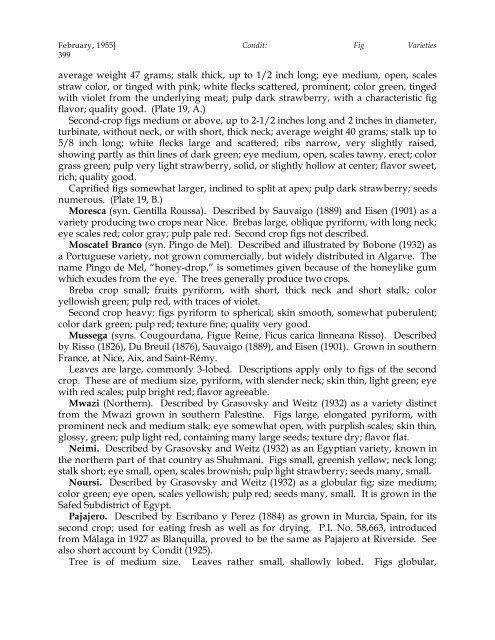Fig Varieties: A Monograph - uri=ucce.ucdavis
Fig Varieties: A Monograph - uri=ucce.ucdavis
Fig Varieties: A Monograph - uri=ucce.ucdavis
You also want an ePaper? Increase the reach of your titles
YUMPU automatically turns print PDFs into web optimized ePapers that Google loves.
February, 1955] Condit: <strong>Fig</strong> <strong>Varieties</strong><br />
399<br />
average weight 47 grams; stalk thick, up to 1/2 inch long; eye medium, open, scales<br />
straw color, or tinged with pink; white flecks scattered, prominent; color green, tinged<br />
with violet from the underlying meat; pulp dark strawberry, with a characteristic fig<br />
flavor; quality good. (Plate 19, A.)<br />
Second-crop figs medium or above, up to 2-1/2 inches long and 2 inches in diameter,<br />
turbinate, without neck, or with short, thick neck; average weight 40 grams; stalk up to<br />
5/8 inch long; white flecks large and scattered; ribs narrow, very slightly raised,<br />
showing partly as thin lines of dark green; eye medium, open, scales tawny, erect; color<br />
grass green; pulp very light strawberry, solid, or slightly hollow at center; flavor sweet,<br />
rich; quality good.<br />
Caprified figs somewhat larger, inclined to split at apex; pulp dark strawberry; seeds<br />
numerous. (Plate 19, B.)<br />
Moresca (syn. Gentilla Roussa). Described by Sauvaigo (1889) and Eisen (1901) as a<br />
variety producing two crops near Nice. Brebas large, oblique pyriform, with long neck;<br />
eye scales red; color gray; pulp pale red. Second crop figs not described.<br />
Moscatel Branco (syn. Pingo de Mel). Described and illustrated by Bobone (1932) as<br />
a Portuguese variety, not grown commercially, but widely distributed in Algarve. The<br />
name Pingo de Mel, “honey-drop,” is sometimes given because of the honeylike gum<br />
which exudes from the eye. The trees generally produce two crops.<br />
Breba crop small; fruits pyriform, with short, thick neck and short stalk; color<br />
yellowish green; pulp red, with traces of violet.<br />
Second crop heavy; figs pyriform to spherical; skin smooth, somewhat puberulent;<br />
color dark green; pulp red; texture fine; quality very good.<br />
Mussega (syns. Cougourdana, <strong>Fig</strong>ue Reine, Ficus carica linneana Risso). Described<br />
by Risso (1826), Du Breuil (1876), Sauvaigo (1889), and Eisen (1901). Grown in southern<br />
France, at Nice, Aix, and Saint-Rémy.<br />
Leaves are large, commonly 3-lobed. Descriptions apply only to figs of the second<br />
crop. These are of medium size, pyriform, with slender neck; skin thin, light green; eye<br />
with red scales; pulp bright red; flavor agreeable.<br />
Mwazi (Northern). Described by Grasovsky and Weitz (1932) as a variety distinct<br />
from the Mwazi grown in southern Palestine. <strong>Fig</strong>s large, elongated pyriform, with<br />
prominent neck and medium stalk; eye somewhat open, with purplish scales; skin thin,<br />
glossy, green; pulp light red, containing many large seeds; texture dry; flavor flat.<br />
Neimi. Described by Grasovsky and Weitz (1932) as an Egyptian variety, known in<br />
the northern part of that country as Shuhmani. <strong>Fig</strong>s small, greenish yellow; neck long;<br />
stalk short; eye small, open, scales brownish; pulp light strawberry; seeds many, small.<br />
Noursi. Described by Grasovsky and Weitz (1932) as a globular fig; size medium;<br />
color green; eye open, scales yellowish; pulp red; seeds many, small. It is grown in the<br />
Safed Subdistrict of Egypt.<br />
Pajajero. Described by Escribano y Perez (1884) as grown in Murcia, Spain, for its<br />
second crop; used for eating fresh as well as for drying. P.I. No. 58,663, introduced<br />
from Málaga in 1927 as Blanquilla, proved to be the same as Pajajero at Riverside. See<br />
also short account by Condit (1925).<br />
Tree is of medium size. Leaves rather small, shallowly lobed. <strong>Fig</strong>s globular,
















![Fig Trees in North Carolina [Archive] - IDigMyGarden ... - Figs 4 Fun](https://img.yumpu.com/26905320/1/190x245/fig-trees-in-north-carolina-archive-idigmygarden-figs-4-fun.jpg?quality=85)